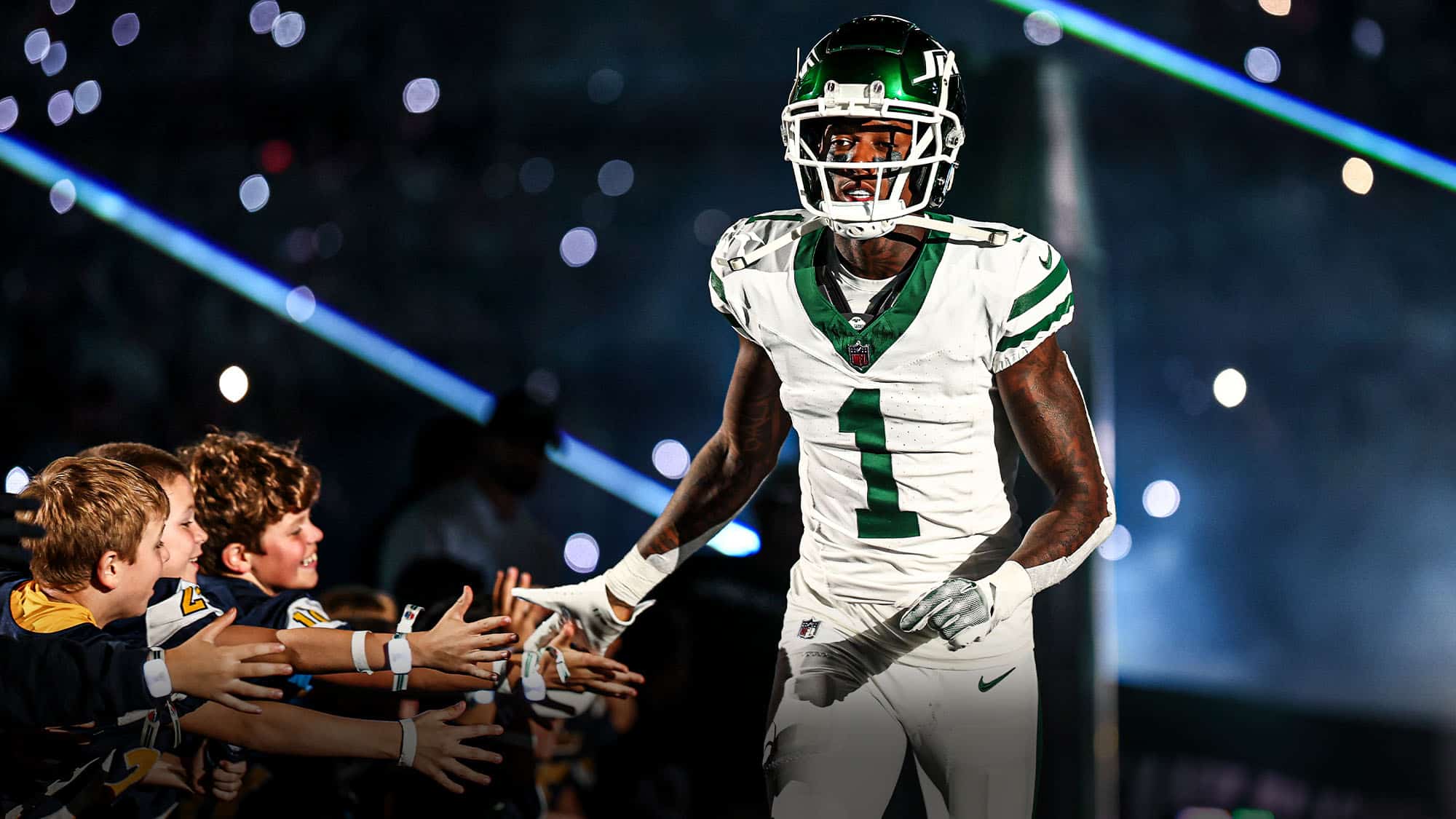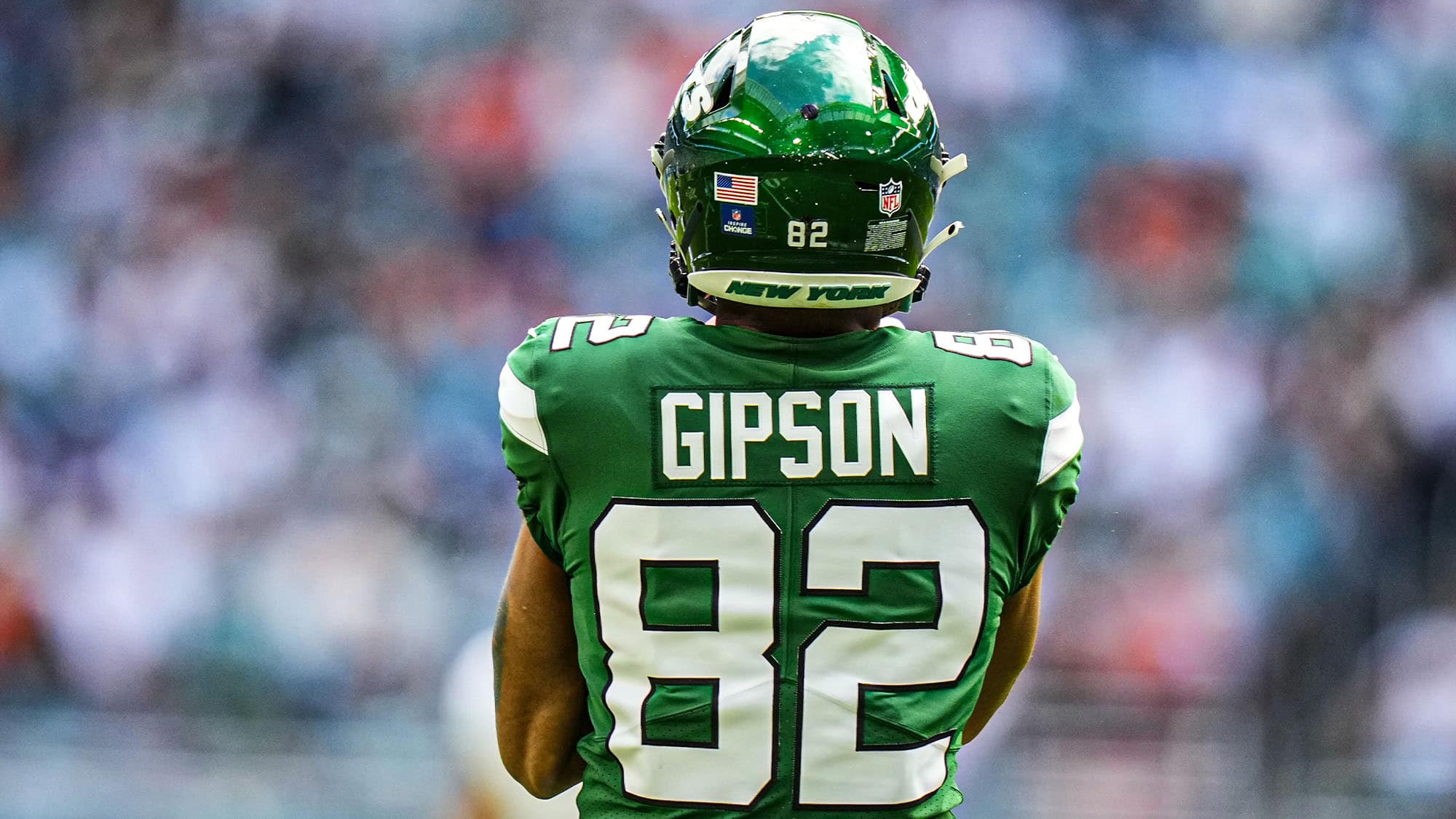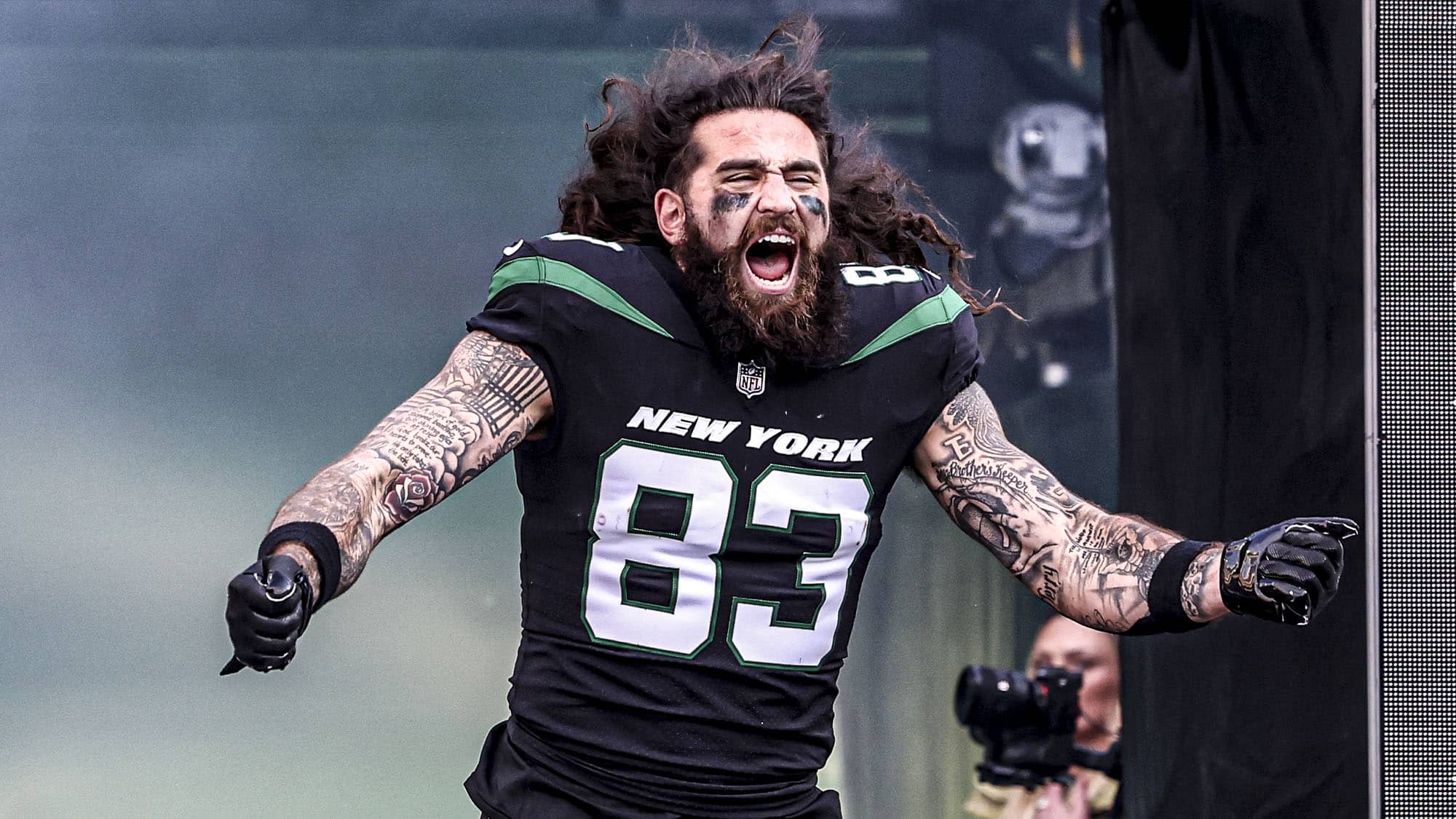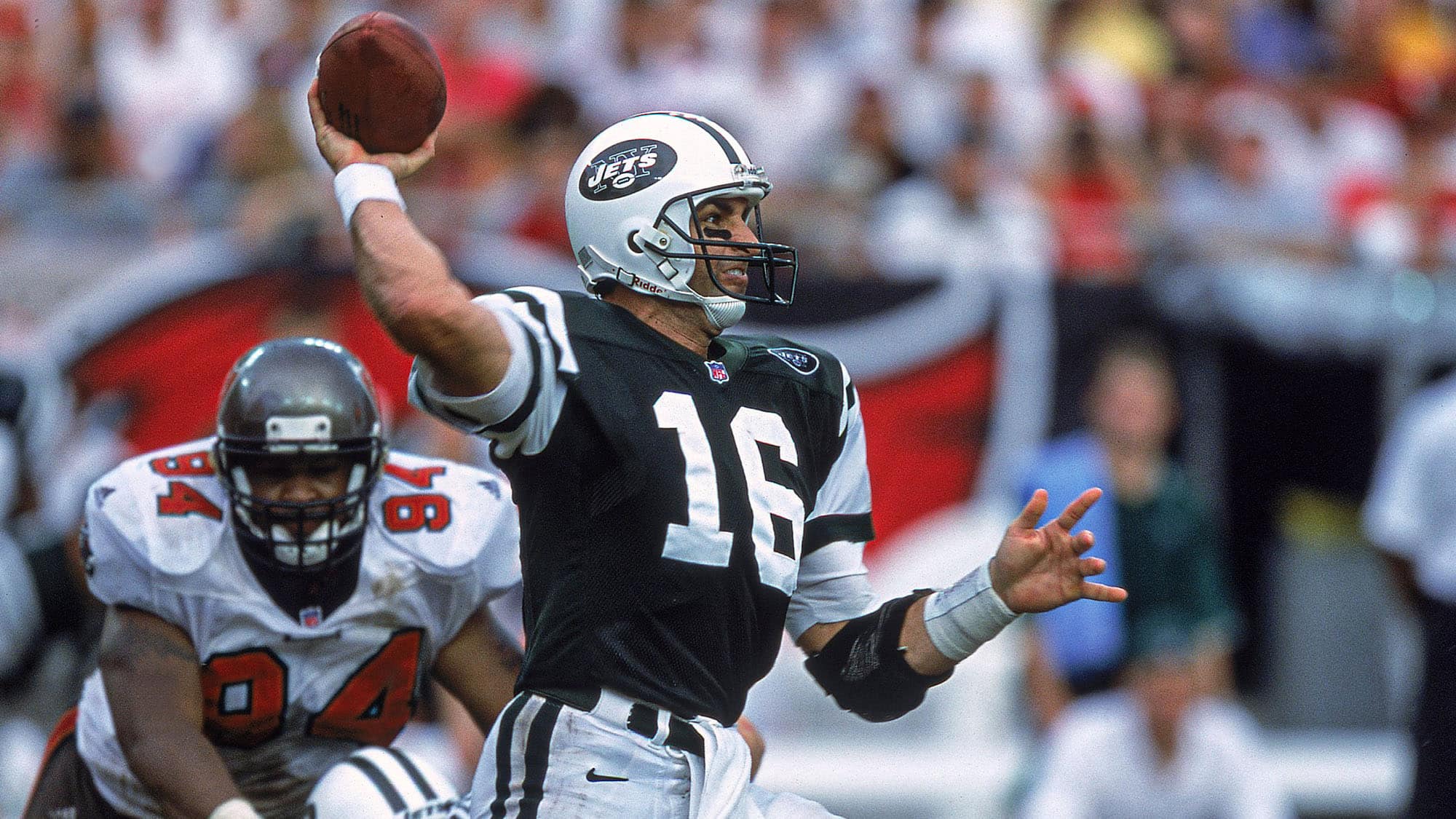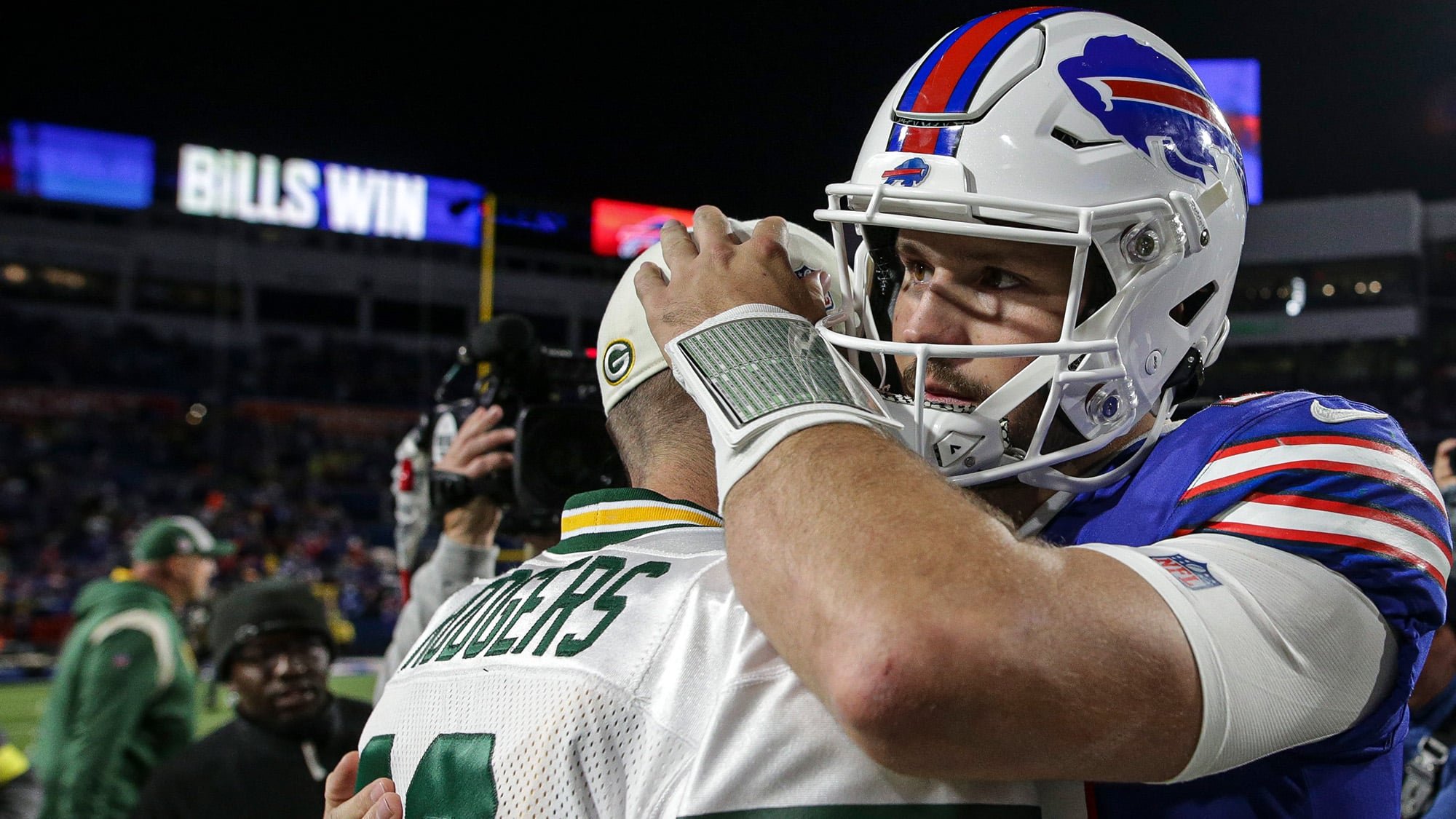A major weakness became a strength for the New York Jets’ defense in 2023
During the 2023 offseason, the New York Jets’ defense seemed destined to weaken. Between enjoying unusually excellent health on the defensive side of the ball in 2022, facing a seemingly more difficult schedule, general defensive variability, and some questionable holes, regression appeared inevitable.
Instead, they did the opposite: the Jets’ defense took a step forward. From a sixth-ranked defensive DVOA (-9.5%) in 2022, they soared to a third-ranked -14.2%. Many aspects of improvement led to this overall step forward, but one overlooked area deserves highlighting.
The Jets somehow figured out how to deal with their kryptonite — covering tight ends.
Before the 2023 season, Michael Nania explained just how negatively the Jets’ coverage of tight ends impacted their entire defense. The team went 3-9 in games where they gave up positive EPA to tight ends and 4-1 in those where the EPA was 0.0 or below. Their struggles against Detroit, Jacksonville, and Seattle near the end of the season illustrated this point perfectly. They allowed a 51-yard game-winning touchdown to little-used backup tight end Brock Wright on 4th-and-1 against Detroit, Evan Engram shredded them to the tune of 7 catches for 113 yards, and no-names Colby Parkinson and Tyler Mabry scored touchdowns against them.
In 2023, the Jets did a much better job covering tight ends. That’s not to say there weren’t blips on the radar, but those only serve to provide evidence that their defense could be even better in that area in 2024.
Overall team statistics
The Jets ranked first in the NFL with a -21.0% DVOA allowed to tight ends. Per NFL Next Gen Stats, they allowed 80 receptions (4.7 per game, 12th) for 825 yards (48.5 per game, 14th) to the position, which doesn’t seem to back up that DVOA ranking. Still, their advanced rankings were far superior to the raw numbers and more in line with the DVOA ranking.
- 87.0 targeted passer rating (6th)
- -4.2% completion percentage over expected (CPOE, 2nd)
- 6.8 yards per attempt (7th)
- 0.0 EPA per dropback (8th)
- 50.4% defensive success rate (8th)
In one way, covering tight ends remained the Jets’ defensive kryptonite: they allowed 8 touchdowns to the position, tied for the second-most in the NFL. However, they also nabbed six interceptions on targets to the tight end, the most in the league. That’s largely how their EPA ended up as good as it did.
Still, the 50.4% success rate on tight end targets is important. It indicates that while the Jets may have allowed a reasonable amount of yardage to tight ends, they kept the damage at bay. A defensive success is a play that constitutes a failure for the offense, generally defined as gaining less than 40% of the required yardage on first down, 50% on second down, and 100% on third or fourth down. Tight ends may have caught some balls against the Jets, but those catches didn’t go that far on a catch-by-catch basis.
The touchdown culprit
If you had to guess which Jets player was primarily responsible for giving up touchdowns to tight ends, you’d probably be right on your first guess. Jordan Whitehead allowed seven touchdowns into his coverage in 2023, the worst mark among safeties, and five of them were to tight ends.
None of Whitehead’s interceptions came against tight ends, either, giving him a targeted passer rating of 149.7 on throws to the position. He allowed a whopping 0.76 EPA per target to tight ends (worst), 12.2 yards per target (worst), 1.8 yards per cover snap (third-worst), and a 31.3% success rate (third-worst) among 40 safeties with at least 10 tight end targets. Whitehead allowed positive EPA to tight ends in eight games, more than any other player on the Jets.
Whitehead’s tight end coverage may have cost the Jets four games in 2023. Against the Patriots in Week 3, a coverage bust led to a 58-yard touchdown to Pharaoh Brown; the Jets ultimately lost 15-10. The following week vs. Kansas City, a 34-yard touchdown to Noah Gray that seemed to be Whitehead’s responsibility (though it may have been Sauce’s missed assignment causing it) made the game 17-0, and the Jets ultimately lost 23-20. Against the Falcons, Whitehead’s 20-yard touchdown allowed to MyCole Pruitt was the lone touchdown in a 13-8 defeat. And Michael Mayer’s touchdown reception over Whitehead was the difference-maker in the Jets’ 16-12 loss to the Raiders.
Replacements
Though the Jets have a safety competition between Tony Adams, Chuck Clark, and Ashtyn Davis this offseason, Clark remains the most likely Whitehead replacement. Though coverage is not generally his forte, he had solid numbers covering tight ends in his last two seasons with the Ravens (2021-22), allowing 14 receptions on 27 targets (51.9%) for 122 yards, 3 touchdowns, 1 interception, a -8.9% CPOE, -4.8 target EPA, 0.5 yards per cover snap, and a 59.3% coverage success rate.
Both Adams and Davis would be major upgrades over Whitehead in covering tight ends, too. Adams had a 66.7% coverage success rate against tight ends in 2023, while Davis allowed just 4 of 10 receptions with 4 passes defensed and a 60% success rate.
It seems that no matter who the Jets choose at safety, they’ll already have an upgrade over Whitehead in covering tight ends. That bodes well for the rest of the team.
Linebackers
Everyone remembers C.J. Mosley lumbering after David Njoku in the Jets’ primetime matchup with the Cleveland Browns. Certainly, Mosley’s declining footspeed puts him at a disadvantage in covering faster tight ends (Njoku’s 4.64 40-yard dash was in the 78th percentile among tight ends at the Combine). That was the Jets’ worst individual performance covering tight ends of the season, as Mosley allowed 7.4 EPA to the position.
Still, outside of that one game, Mosley’s next-most EPA allowed to tight ends in a single game was 0.5. Among 78 linebackers with at least 30 cover snaps vs. tight ends, he tied for 22nd with a 50% coverage success rate, ranked 20th with a -8.9% CPOE, and tied for 16th with a 20% tight-window rate (<1 yard of separation). He did allow 8.2 yards per target to the position (40th) and 0.19 EPA per target (T-41st), so he certainly had his struggles against tight ends. Still, he’s not as horrendous a liability in that area overall as he may have seemed in that Cleveland game.
Then again, with another season of wear and tear, he could fall off a cliff in 2024 — particularly when facing George Kittle (4.52 40-time, 94th percentile), Trey McBride (4.56 at pro day), Jelani Woods (4.61), Jonnu Smith (4.62), Evan Engram (4.42), Hunter Henry (4.68 at pro day), Tyler Higbee (4.67 at pro day), Noah Fant (4.5), and Chigoziem Okonkwo (4.52).
Quincy Williams’ numbers against tight ends improved tremendously in 2023, perhaps leading the Jets’ overall transformation against the position. Here is his number comparison from 2022-23.
| 2022 | 2023 | |
|---|---|---|
| Targets | 18 | 13 |
| Receptions allowed | 17 | 9 |
| Completion % | 94.4% | 69.2% |
| Yards | 144 | 47 |
| TD:INT | 1:0 | 0:0 |
| Passes defensed | 0 | 1 |
| CPOE | 18.4% | -0.1% |
| EPA per target | 0.53 | -0.37 |
| Tight window % | 5.6% | 15.4% |
| Yards per target | 8.0 | 3.6 |
| Coverage success rate | 33.3% | 46.2% |
| Yards per cover snap | 1.6 | 0.4 |
| Open rate | 50% | 38.5% |
Williams improved tremendously in every single area. His move toward an average coverage success rate (54th percentile) made the biggest difference for the Jets’ defense.
Cornerbacks
Among 77 cornerbacks with at least 60 coverage snaps against tight ends, D.J. Reed had the eighth-most targets (16). He struggled somewhat, allowing 0.22 EPA per target (42nd percentile) and a 43.8% coverage success rate (40th). His 62.5% open rate was in the 30th percentile. Reed was particularly victimized by Kansas City (3-of-3, 32 yards) and Cleveland (1-of-1, 28 yards). He allowed positive EPA to tight ends in six separate games.
Sauce Gardner was targeted far less often against tight ends but also had his struggles, allowing 7 of 8 receptions for 35 yards and a touchdown with 0.26 EPA per target. Still, his 62.5% coverage success rate against tight ends ranked in the 74th percentile among corners, demonstrating that he kept the damage to a minimum most of the time. Gardner allowed positive EPA to tight ends in three games (Dallas, Kansas City, Denver).
Michael Carter II was the best of the three, posting a 66.7% success rate (87th percentile). He allowed 6 of 9 receptions for 62 yards, but only three of those six receptions resulted in an offensive success.
Overall, the cornerbacks weren’t great against tight ends, but they were serviceable enough.
Looking ahead
The biggest X-factor against tight ends in the Jets’ defense seems to be the safety position. Whitehead was the biggest culprit in 2023, which means that if his replacement can just sustain a decent level of play against the position without blowing coverages, the defense should be even better. The issue was those busts in both 2022 and 2023, and Whitehead played a big part.
Additionally, while Mosley was below average in tight end coverage in 2023, the Jets need him to sustain that level of play rather than falling further. If Quincy Williams can keep up his improvements from 2023, the Jets’ linebackers can do a decent overall job covering tight ends. Quincy was the other player whose busted coverage against tight ends caused issues in 2022.
The Jets don’t face an easy slate of tight ends in 2023. Assuming Hockenson is healthy by Week 5, they face three of the top five and five of the top 10 in receiving yards at the position (Kittle, Engram, Hockenson, McBride, Dalton Kincaid). Dalton Schultz and Jonnu Smith, 12th and 15th respectively, are weapons in potentially elite passing offenses.
The key against these players is not to allow them to gain big chunks of yardage and to keep them out of the end zone. That was the Jets’ biggest problem against the position in 2022 and 2023. With Whitehead gone, the potential for a vast improvement in both areas is there. That’s saying something for a team that already posted solid numbers against tight ends in 2023.


